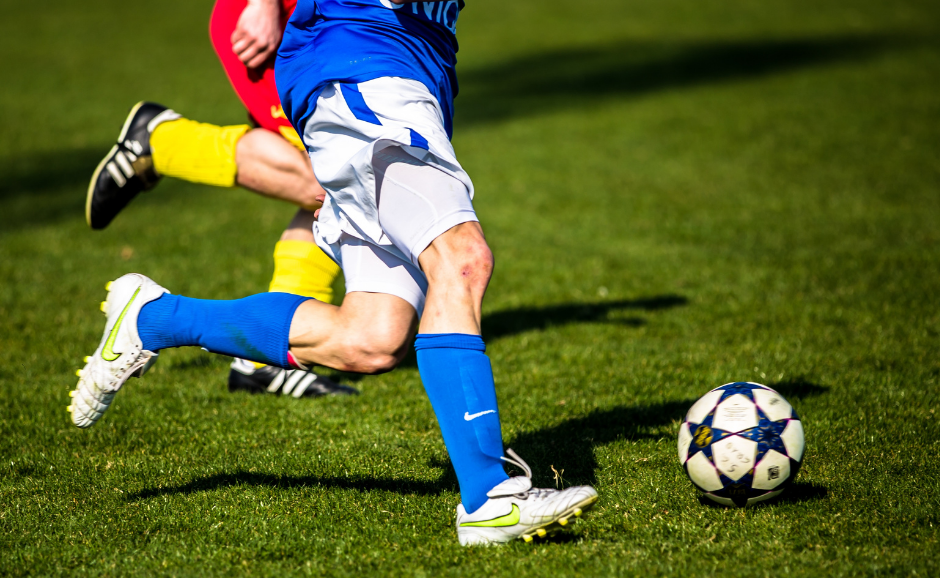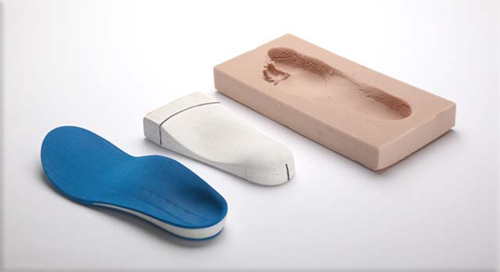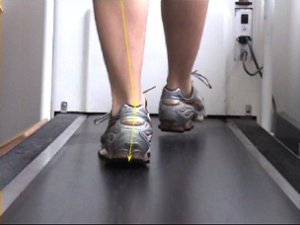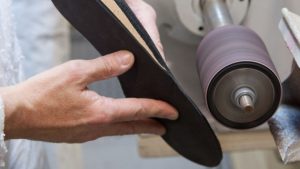
When you hear about your friend’s orthotics from the pharmacy helping cushion their feet, your colleague’s new pair of shoes coming with in-built orthotics for support, or your young niece’s orthotics that stopped her from in-toeing, understanding how orthotics could help you recover from or prevent injuries when you’re playing sports can get really confusing.
The reality is that custom foot orthotics are a powerful and specialised treatment tool that improves the lives of our patients every day. Our podiatrists use orthotics to help treat a range of injuries sustained during sports, as well as helping prevent the injury from recurring or developing in the first place. But what exactly are orthotics, how do they work to help with such a wide range of problems, and what conditions can they help with? Today, our podiatrists are talking all about foot orthotics for sports injuries.
What Are Foot Orthotics?
Custom foot orthotics are medical shoe inserts that adjust the way that your feet are positioned and aligned when standing on them, which affects the way your feet and legs work together to produce movement, which we call biomechanics. They can also offload painful areas of the foot, give you greater support in the areas you need it, add more stability to your ankle, help your feet better absorb shock, correct a leg length difference, and act in many other ways that they are carefully designed to.
How Can Orthotics Help With So Many Problems?
The easiest way to answer this is by considering how prescription glasses can help with so many different – and often opposite – vision disturbances. The answer? Because that’s how your optometrist prescribes them. It’s exactly the same with our orthotics.
Our podiatrists have extensive knowledge on how to manipulate your foot alignment and biomechanics to produce the specific results you need, based on the problems you’re experiencing and the findings of your clinical and gait exam. We combine this with a 3D digital cast of your foot, to produce a pair of custom foot orthotics that are completely unique and made for your feet.
Every aspect of your orthotics is carefully selected – from how many degrees your heel will be inverted or everted to help optimise your performance on the field, to how each joint at the ball of your foot will sit to help prevent a specific joint from being overloaded and painful, to how thick your heel cushion should be to help your body better manage the forces as you sprint along the track. Every pair of custom foot orthotics we dispense is created with significant skill, experience and care – and with one clear goal: to improve your quality of life by helping you reach your goals, whether that’s pain relief, optimising your sports performance, preventing future problems or something else.
Can I Use Orthotics From The Supermarket Or Pharmacy?
You know how people can refer to both their supermarket glasses and their prescription optometrist glasses as just ‘glasses’? It’s the same umbrella term with orthotics.
The products you purchase out of a packet can be referred to as ‘orthotics’, but really they are cushioned ‘inserts’. These inserts are created using the same mould in a factory, with stock standard sizing, no consideration of your problem, what caused it, your unique circumstances or medical conditions, or how the bones and joints of your feet are aligned or functioning. For those who employ marketing tactics to target a specific condition (often heel pain), they presume that all feet are the same and need the same care – which couldn’t be further from the truth.
Ultimately, this is why many people talk about their frustration with their ‘orthotics’ – having purchased this stock-standard option and feeling frustrated that they didn’t work for them like their friend’s custom prescription orthotics did – without understanding that the two products couldn’t be more different.
Orthotics For Sports Injuries
When we injure our hand, for example, we can go a long way in performing alternate movements so that we minimise how much we use the injured hand, therefore preventing overloading it and worsening the injury. When it comes to the feet and legs, this is much more difficult because we lead busy lives and can’t just stop walking to let the damaged structure rest. This is where orthotics come in.
Custom foot orthotics are often a key part of a treatment plan for a sports injury because the orthotics can be specifically designed to offload the injured structure every time you walk, while supporting the associated bones, muscles and ligaments to help reduce the stress and tension on them. This means that you can still lead a normal life – going to work and spending time with your families – while remaining on the path to recovery.
If the injury was caused by alignment issues in the feet – like a flat foot type that was straining the plantar fascia – continuing to wear orthotics when playing sports after you have recovered can help prevent the injury from recurring, by keeping the arches supported.
Which Sports Injuries Can Foot Orthotics Help Treat?
While we highly recommend seeing your podiatrist to check if orthotics are right for you and your injury, some common injuries that we often use orthotics to help treat include:
Beyond Sports Injuries
While getting injured in sports is one way to stop you from being on the field or doing the things you love, there are other conditions and problems that can get in the way of your athletic pursuits that orthotics can help with. Knee osteoarthritis is a common example, with orthotics being proven to help relieve the pain associated with knee arthritis affecting the inside (medial aspect) of the knee.
Are Orthotics Right For You?
The only way of knowing if orthotics are right for you or could help you is by speaking to one of our experienced podiatrists. For any questions or to book an appointment, give us a call on 09 523 2333 or book online here.

Orthotics can be fantastic devices. Like glasses that help us see and perform our best each day, orthotics work to alter the way our feet, muscles and bones move with the goal of optimising our overall function and reducing pain, excess pressure and unnecessary fatigue.
Unlike glasses, however, that do not come into direct contact with our eyes, the daily force placed on the orthotic can cause them to wear out over time. While this is not new information and is (or at least should be) detailed by your Podiatrist when discussing orthotics, it is something that can be easily forgotten or taken for granted when your foot pain is gone and you’re performing well – until your pain quickly returns and you’re not sure why.
To put things in perspective, here are 3 quick reasons why you should be seeing your Podiatrist for an orthotic check every year – or two at most.
1. Regardless of how long you’ve had them, your orthotics are working every day.
 Whether you realise it or not – your orthotics are constantly under a lot of pressure. To be precise, you’ll be exerting at least all your body weight over both orthotics – and when you’re running, this can increase to 3 – 4 times your body weight.
Gradually, this can lead to the wear down and compression of your orthotic materials, which affects their ability to provide the support, control and function that they were designed to – and initially would have.
Just like how you’d sharpen a blunt knife so it could keep working effectively, it’s important to check that your orthotics are still doing their job. If they’re not, it doesn’t mean that you’ll always need a completely new set of orthotics. Sometimes, it’s simply a matter of replacing the top cover, reinforcing the control of your orthotics or replacing your pad or addition. You won’t know until you have them checked – and it can be as quick and easy as a 15min check appointment!
Whether you realise it or not – your orthotics are constantly under a lot of pressure. To be precise, you’ll be exerting at least all your body weight over both orthotics – and when you’re running, this can increase to 3 – 4 times your body weight.
Gradually, this can lead to the wear down and compression of your orthotic materials, which affects their ability to provide the support, control and function that they were designed to – and initially would have.
Just like how you’d sharpen a blunt knife so it could keep working effectively, it’s important to check that your orthotics are still doing their job. If they’re not, it doesn’t mean that you’ll always need a completely new set of orthotics. Sometimes, it’s simply a matter of replacing the top cover, reinforcing the control of your orthotics or replacing your pad or addition. You won’t know until you have them checked – and it can be as quick and easy as a 15min check appointment!
2. If your orthotics helped alleviate your original symptoms – how would it affect your life if they came back?
Orthotics are not an ‘on-the-whim’ purchase. They’re a medical device and an investment into your health and mobility for the years to come. They have a very specific function that was prescribed and created by a foot health professional with years of experience in relieving symptoms and improving quality of life. This function may be to stop your foot rolling in and flattening so much, as it was irritating your posterior tibial tendon or plantar fascia and causing pain down the inside of your foot and ankle or the heel. It may be to provide additional stability to your foot and ankle as you’d suffered repeated ankle sprains and had developed some chronic ankle instability along the way. It may have been because your high-arched foot was lacking the shock absorbing function it needed to keep your feet from feeling sore and tired after a long shift on your feet.
Whatever the function – if your pain was alleviated (or at least significantly reduced in the case of arthritic pain) by your orthotics, then there’s a good chance that without the adequate support and control from your orthotics, that this pain can come back. And it’s not only the pain that comes back.
Pain happens for a reason. It’s a sign that something is wrong – that an injury has occurred – and the pain is a by-product of the damage. When your pain comes back, it means an injury has again occurred and that’ll take time to heal and for the pain to go, even after you repair or replace your orthotics. And that can take a significant toll on your quality of life!
3. Your foot structure and position, along with your bone and muscle strength and function, change over time. Your orthotics may need to too.
 As with everything in our lives, we are always changing – and so are our bodies. Our muscles may grow stronger or weaker. Certain medications or events may affect our tissues and the way they function. Our feet change, but they do so very gradually, at a rate that we may not be able to notice. So while we may presume that our feet are the same today as they were 3 years ago, there’s only one way to find out – and that’s to have them checked!
When you come in for an orthotic check, we assess the function of your orthotics against both the reason you needed your orthotics in the first place, and against your feet in their current state. The ultimate question that we look to answer is:
As with everything in our lives, we are always changing – and so are our bodies. Our muscles may grow stronger or weaker. Certain medications or events may affect our tissues and the way they function. Our feet change, but they do so very gradually, at a rate that we may not be able to notice. So while we may presume that our feet are the same today as they were 3 years ago, there’s only one way to find out – and that’s to have them checked!
When you come in for an orthotic check, we assess the function of your orthotics against both the reason you needed your orthotics in the first place, and against your feet in their current state. The ultimate question that we look to answer is:
“are your orthotics in their current state effectively supporting and controlling your feet in their current state?”
If the answer to this question is yes, then that’s fantastic! It’s exactly what we want. If the answer to this question is no, then we’ll figure out why (is it your feet, is it the orthotics, are there other influencing factors like your footwear) and discuss with you the best ways to correct this so you can stay happy, healthy and active for the foreseeable future.
Need that orthotic check after all?
Easy – just book in using our free online booking form here, or give our team a call on 09 523 2333 and book in your appointment. We hope that you’ve been feeling great and performing well – and hope to see you soon!


 Whether you realise it or not – your orthotics are constantly under a
Whether you realise it or not – your orthotics are constantly under a  As with everything in our lives, we are always changing – and so are our bodies. Our muscles may grow stronger or weaker. Certain medications or events may affect our tissues and the way they function. Our feet change, but they do so very gradually, at a rate that we may not be able to notice. So while we may presume that our feet are the same today as they were 3 years ago, there’s only one way to find out – and that’s to have them checked!
As with everything in our lives, we are always changing – and so are our bodies. Our muscles may grow stronger or weaker. Certain medications or events may affect our tissues and the way they function. Our feet change, but they do so very gradually, at a rate that we may not be able to notice. So while we may presume that our feet are the same today as they were 3 years ago, there’s only one way to find out – and that’s to have them checked!